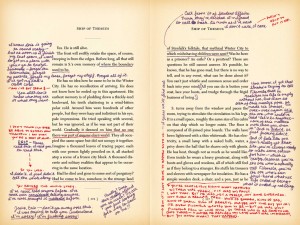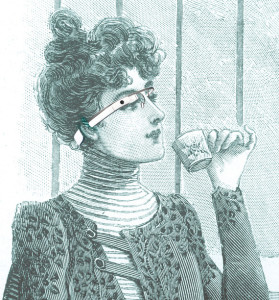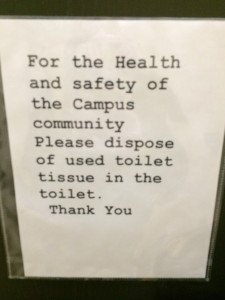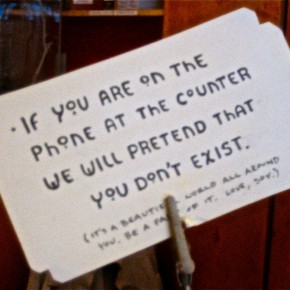META-ANNOTATING!
In class today, the lion’s share of our discussion was predicated on a discussion of annotations in works, and their pros and contras in both traditional manuscript format and digital editions of works. In this blog post, I simply want to share two works dealing with these themes and review them to a limited extent in case they meet anyone’s further fancy.
The first is Mark Z. Danielewski’s novel, House of Leaves. If anyone has read it, or simply opened it to skim a few pages (you should do this, the hyperlink is to it in the Milne catalogue), you will see why it’s so difficult to explain.
To begin, it should be explained that as an entire whole, the book is composed as ergodic literature, defined superbly as Espen J. Aarseth, the coiner of the term:
“In ergodic literature, nontrivial effort is required to allow the reader to traverse the text. If ergodic literature is to make sense as a concept, there must also be nonergodic literature, where the effort to traverse the text is trivial, with no extraoematic responsibilities placed on the reader except (for example) eye movement and the periodic or arbitrary turning of pages.”
The concept is best shown through a visual:

Danielewski’s novel contains colored text (for example, the word “house” always appears in blue ink, most probably alluding to the blue-hued Internet hyperlink), sideways text, mirror writing, writing in different shapes, etc. More notably, and annoyingly, are the thousands and thousands of increasingly abstract and erudite footnotes1 . Danielewski uses this purposefully frustrating technique to create a satire of criticism in academia, notably literature studies, which is how he views the opinion of the “general public” on literary studies; that of a society looking scathingly upon a seemingly, purposefully difficult field of study– and possibly worthless, in the end.
Ironically, Danielewski fails to fully portray the frustration factor of this satire, because for all this mess, his narration carries us on, trudging and complaining, through the hundreds of pages. The story of the House of Leaves is really three: that of Zampanò’s (1) notes on the Navidson Record (2), a set of documents about an [ex-]adventurer who discovers in his newly purchased, seemingly domestic and plain house an impossibly huge labyrinth. First seen as just a discrepancy between the dimensions of the house (the inner dimensions are larger than the outer dimensions by a quarter of an inch), the interior of the house
3 soon grows astonishingly large, to utterly fantastic dimensions, of huge, hulking hallways of eerie grey walls, all of which possess… nothing. As the house grows, nothing is found within the huge abyss as they explore except an eerie growl (the source of which, be it the house or the adventurer, Will Navidson, is never explicitly confirmed). The final story is that of Johnny Truant (3), who finds the notes of the just-murdered (?) Zampanò, and then rambles in his footnotes about his personal life. Ultimately, the story questions what we find, if anything, as we dive deeper and deeper into literature– are the meanings we find our own, or the author’s intended? Etc. etc.
Though we who hate footnotes may find this complicated (again, purposefully) book unappetizing at first glance, it really is a good book. It is a horror story (the unending, ever-expanding labyrinth…) and love story (Will and his wife) in addition to a satire. Just for kicks, I would suggest going to see it in Milne and flicking through it just to see how crazy the book’s style is (and how Danielewski portrays the “general public’s” perception of erudite literary studies– it is so off the mark, even to english students, that most of us, I think, will be astonished, lose our confidence and interest, as we stare at this immense, labyrinthine book).
– – – – – –
The other book I will mention more briefly (having not yet finished it) is the novel S., by J. J. Abrams and Doug Dorst. It, too, is a story within a story. The “real story” is called The Ship of Theseus, and is about a man (S) who has lost his memory. It is written by the fictional author V. M. Straka, whom the other story revolves around. Notes in the margins are from Jennifer and Eric, two college students trying to uncover the mysterious of this mysterious Straka figure. There are notes from both Eric and Jennifer on their first read, their second read, and so on, leading to a rainbow of colors in the margins denoting the chronology of the notes.


In addition to the notes in the margins, there are further items stuffed within the pages, such as government documents, maps drawn on napkins, etc., which Jennifer and Eric put in, lending itself ideally to our discussion of the fluid-text edition of Walden, wherein Thoreau had multiple versions of his work which scholars had to piece together in a roughly chronological and version sequence, as well as any writings in his journals which were drawn on in Walden itself. It is interesting to see, rather than older and younger versions of a literary work juxtaposed together to compare and contrast, older and younger memories of a romantic relationship bound in the margin, side by side.
I think anyone who is a bit sketchy on the success of things such as public annotations and comments should check this book out. While things like Kindle seem to be a bit impersonal and distracting (“1,233,939 people highlighted this sentence”), S. creates a very personal story in the margin itself between just two people.
– – – – – – – – – – – –
Anyway, just thought I’d suggest these two books for anyone interested in the topic. The first one is in Milne, as I’ve linked to, and S. you’ll have to buy, unfortunately, if you want to read it, most likely (though I own a copy if you want to look at it to get a better idea of what it looks like). Sorry if the descriptions seemed a bit confusing– as I mentioned, Danielewski’s novel is purposefully confusing, and S. I haven’t finished yet! If anyone else has read these and want to expand on my brief descriptions, feel free!
-Matt Spitzer
—————————————-
1Some footnotes are outright invented sources and authors, while others are from real sources. The number of footnotes is in the hundreds, if not thousands.2
2Including footnotes of footnotes
3 The online forum for readers of the work, who try to solve what is probably a purposefully unsolvable puzzle.











